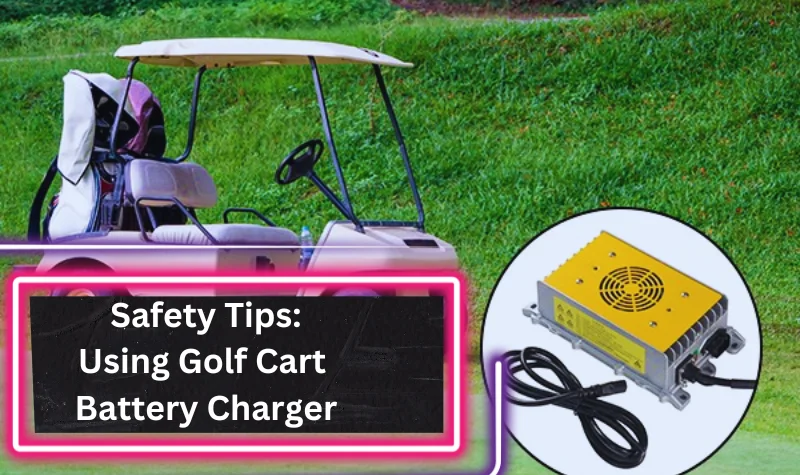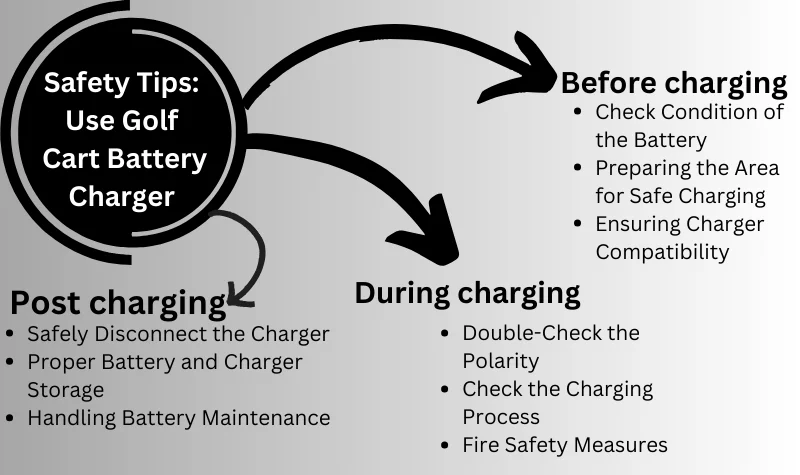Safety Tips When Using a Golf Cart Battery Charger

Golf Cart Battery Chargers are an essential tool for every golf cart owner. They ensure that your vehicle is running smoothly across the greens. They’re designed to charge the batteries that power your golf cart. They provide you with reliable and long-lasting performance. Golf cart battery chargers come in various shapes and sizes. But their main purpose remains the same: to recharge your batteries after use.
However, like all electrical devices, they demand careful and mindful use. In this article, we will discuss some crucial safety tips when using a golf cart battery charger. These tips will enhance performance while prioritizing safety.
Understanding Golf Cart Battery Chargers
Before diving into safety precautions, let’s start with a brief overview of how a golf cart battery charger works. A golf cart battery charger is designed to recharge the batteries that power the cart. It delivers an electric current to the battery, replenishing its charge and allowing it to function properly. It’s important to note that all golf cart battery chargers are created with varying features. There are different types available, including onboard chargers and portable chargers. It’s vital to choose the right charger for the Golf cart model.
Tips to use Golf Cart Battery Charger safely
 Safety Precautions Before Charging
Safety Precautions Before Charging
One must follow several precautions before connecting the charger to your golf cart battery. These are to ensure safe and efficient charging.
- Checking the Condition of the Battery: Inspect the battery for any visible wear and tear, including cracks, leaks, or bulges. If you notice any damage, it’s crucial to address it before attempting to charge the battery. Additionally, check the battery terminals for any corrosion and clean them if necessary.
- Ensuring Charger Compatibility: Confirm that the battery charger you are using is compatible with your golf cart battery. Check the voltage specifications of the charger and ensure that it matches the voltage of your battery. Using an incompatible charger can lead to improper charging and potential damage to the battery.
- Preparing the Area for Safe Charging: Before connecting the charger, make sure the charging area is well-ventilated and free from any flammable materials. It’s also advisable to have a fire extinguisher nearby as an added safety measure. Creating a safe and suitable environment for charging is essential to prevent accidents or damage.
Safety Measures During Charging
After safety precautions, it’s important to practice safety measures during the charging process.
- Double-check the Polarity: Before connecting the charger to the battery, ensure that the polarity is correct. Connecting the charger cables incorrectly can result in reverse charging, which can damage the battery. Always refer to the manufacturer’s instructions and follow the proper way to connect the golf cart battery charger. Correct connections of charging cables include positive to positive and negative to negative.
- Check the Charging Process: While the battery is charging, it’s crucial to keep an eye on the process. Avoid leaving the battery unattended for extended periods. Check the battery regularly for any signs of overheating or unusual behavior. If you notice any issues, such as excessive heat or strange odors, then disconnect the charger and seek professional help.
- Fire Safety Measures: It’s important to have a fire extinguisher nearby. Familiarize yourself with emergency procedures in case of a fire. Ensure that all individuals involved in the charging process are aware of them. Some emergency procedures include disconnecting the charger from the power source and unplugging it from the golf cart. Never leave the charging process unattended.
Dos and don’ts to prevent damage or accidents:
- Do: Follow the recommended charging time and avoid overcharging.
- Do: Check that all connections are secure before starting the charging process.
- Do: Keep the battery and charging area dry to avoid electric shocks or short circuits.
- Don’t: Charge a damaged or frozen battery.
- Avoid Overheating: During the charging process, it’s essential to watch the temperature of both the battery and charger. If either becomes
- Don’t: Leave the charging process unattended.
- Don’t: Use a damaged charger or battery.
III. Post-Charging Safety Tips
After charging, must follow certain safety measures before disconnecting the charger. Here are some safety tips to consider:
- Safely Disconnect the Charger: When disconnecting the charger, always start by turning off the charger. Then unplugging it from the power source. Afterward, disconnect the charger from the battery terminals as per the manufacturer’s instructions.
- Proper Battery and Charger Storage: Store your battery and charger in a cool, dry place when not in use. Avoid exposing them to extreme temperatures or direct sunlight. This is because then sunlight can affect their performance and lifespan.
- Handling Battery Maintenance: Regularly inspect your battery for any signs of damage or corrosion. Clean the battery terminals by using a battery terminal cleaner and a wire brush if necessary. Avoid using water or solvents for cleaning, as this can damage the battery.
Common Mistakes to Avoid

For a safe and efficient charging process, it’s important to steer clear of common mistakes that can lead to accidents or damage to the battery. Here are some common mistakes to avoid:
· Ignoring Visible Wear and Tear or Damage: Always inspect your battery before charging and address any visible wear and tear or damage.
· Failing to Check Compatibility: Using a charger that is not compatible with your battery can lead to undercharging or overcharging. This improper charging can damage the battery.
· Neglecting Good Ventilation: Lack of proper ventilation during the charging process can enhance safety risks. The dangerous gases can accumulate in the congested environment.
· Incorrectly connecting the Charger: Incorrectly connecting the charger can result in reverse charging. This reverse charging can damage the battery and reduce its lifespan.
· Leaving the Battery Unattended: Never leave the battery unattended during the charging process. It’s important to monitor the charging progress and be prepared to take action if any issues arise.
Conclusion:
In conclusion, maintaining safety and efficiency while charging your golf cart battery requires attention to detail and adherence to recommended guidelines. From pre-charge safety measures to post-charge handling, each step plays a vital role in ensuring the longevity and optimal performance of your battery.
FAQS:
Is it necessary to read the instruction manual before using a battery charger?
Yes, reading the instruction manual is essential. Each battery charger may have specific instructions and safety precautions that need to be followed. The manual will provide you with valuable information on proper usage, charging procedures, and any potential risks associated with the charger.
Are there any specific charging recommendations for different types of batteries?
Yes, different types of batteries may require specific charging recommendations. It is important to refer to the manufacturer’s guidelines for your specific battery type. They will provide instructions on charging voltage, current, and duration for optimal battery performance and safety.
How do I ensure proper ventilation during the charging process?
Proper ventilation is crucial when using a battery charger. Ensure that the charging area is well-ventilated. It will prevent the accumulation of harmful gases. Therefore, charging in an open or well-ventilated area is recommended.
What should I do if I notice any unusual behavior or smell during charging?
If you notice any unusual behavior, such as excessive heat, smoke, sparks, or a strong smell of sulfur, disconnect the charger from the power source and contact a professional. These signs may show a problem with the battery or charger. Therefore, it is important to address them to prevent any safety hazards.
Read related articles:
best golf cart fans 2024
easiest golf ball color to see


 Safety Precautions Before Charging
Safety Precautions Before Charging










